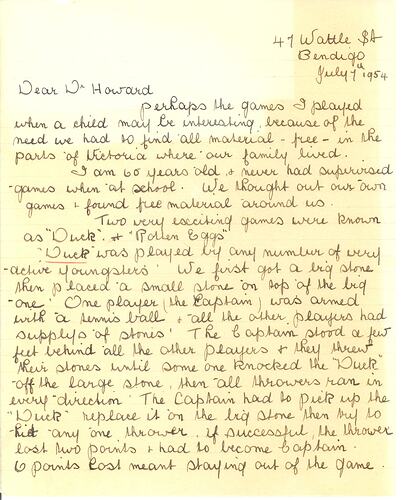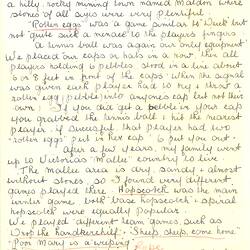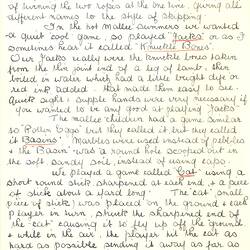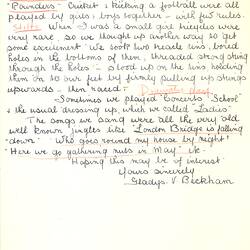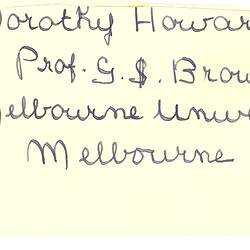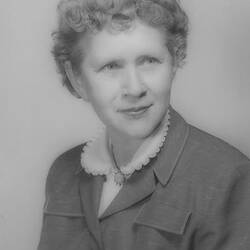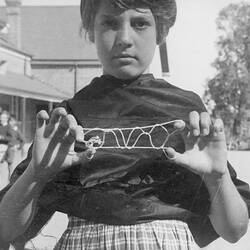Summary
Game names (and types): 'Ducks', 'Rotten Eggs', 'Rounders', Football (ball games), Hopscotch, 'Base Hopscotch', 'Spiral Hopscotch' (hopscotch), 'Drop the Handkerchief' (circle game), 'Sheep, Sheep, Come Home', 'Poor Mary is Weeping' (team games, unknown types), 'French Skipping', 'German Skipping', 'English Skipping' and 'Dutch Skipping (skipping rope games), Knucklebones, Jacks (knucklebones, jacks use), 'Basins' (marbles), 'Cat', 'Stilts' (play with props/equipment), Hide and Seek (hiding game), 'Concerts', 'School', 'Ladies' (dramatic play), 'London Bridge is Falling Down', 'Who Goes Round My House by Night?', 'Here We Go Gathering Nuts in May' (rhymes)
Alternative type: chasing game, running game, jumping game, language play, bat and ball games
Handwritten letter composed by Gladys V. Beckham addressed to Dr Dorothy Howard on 7 July 1954. In her letter to Dr Howard, Beckham describes a number of games played during her childhood in Maldon and the Mallee country in rural Victoria. She writes that all games were unsupervised and involved finding free materials in the surrounding environment. For example, the ball games 'Ducks' and 'Rotten Eggs' involved a tennis ball and many stones, the latter being plentiful in the rocky mining town of Maldon. Beckham states that she was introduced to a new set of games following her family's relocation to the dry and sandy Mallee country. She writes that Knucklebones and 'Jacks' were quiet, cool games suitable for play in the hot Mallee summers. All descriptions include the number of players involved, the equipment needed and the rules.
One of a collection of letters describing a children's game written to children's Folklorist Dorothy Howard between 1954 and 1955. Dr Howard came to Australia in 1954-55 as an American Fulbright scholar to study Australian children's folklore. She travelled across Australia for 10 months collecting children's playground rhymes, games, play artefacts, etc. This letter, together with the other original fieldwork collected by Dr Howard during this period, is preserved in the Dorothy Howard Collection manuscript files, part of the Australian Children's Folklore Collection (ACFC), Archive Series 3. The ACFC is an extensive collection documenting children's folklore and related research.
Physical Description
Handwritten letter in black ink on lined paper. Four pages printed on one side only. Features annotations in a different hand in red pencil overall. Accompanied by partial envelope with annotations on front and back.
More Information
-
Collection Names
Australian Children's Folklore Collection, Dorothy Howard Collection
-
Collecting Areas
-
Acquisition Information
Cultural Gifts Donation from Dr June Factor, 18 May 1999
-
Acknowledgement
Donated through the Australian Government's Cultural Gifts Program.
-
Author
Gladys V. Beckham, Wattle Street, Bendigo, Victoria, Australia, 7 Jul 1954
-
Addressed To
Dr Dorothy Howard, University of Melbourne, Carlton, Greater Melbourne, Victoria, Australia, 7 Jul 1954
-
Collector
-
Inscriptions
Handwritten annotations on envelope: on front 'Dr Dorothy Howard / C/o Prof. G. S[crossed out]. Browne / Melbourne University / Melbourne'; on reverse: 'Beckham, Gladys V. / Victoria'.
-
Classification
-
Category
-
Discipline
-
Type of item
-
Overall Dimensions
198 mm (Width), 247 mm (Height)
Orientation: portrait. Note: dimensions are pages of letter only.
-
Keywords
